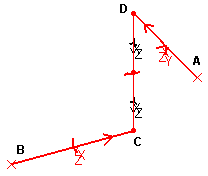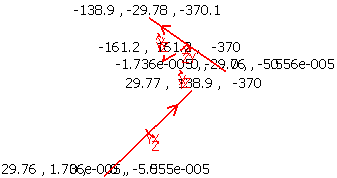This test lets you check space structure on elastic support, in the context of a static case. You will use 1D mesh. This test is used to validate the discrete elastic coupling.
Reference:
AFNOR technique, SFM Paris, Guide de validation des progiciels de calcul de structures, SSLL 04/89, pp.26-27, 1990.
 Specifications
Specifications
Geometry Specifications
|
Length: |
|
|
Inertia: |
|
|
Area: |
Analysis Specifications
|
Young Modulus (material): |
|
|
Poisson's Ratio (material): |
|
|
Loads (traction at D): |
|
|
Restraints:
|
|
 Results
Results
The results correspond to the quantity at each point and
according to x, y, or z.
The table below presents the beam output results.
|
Point |
Quantity |
Reference |
Computed result |
|
A |
Mx [N_m] |
-8437.5 |
-8438.14 |
|
A |
My [N_m] |
-1562.5 |
-1562.3 |
|
A |
Mz [N_m] |
3125.0 |
3124.6 |
|
B |
Mx [N_m] |
1562.5 |
1562.5 |
|
B |
My [N_m] |
8437.5 |
8437.05 |
|
B |
Mz [N_m] |
3125.0 |
3125.0 |
|
A |
v [mm] |
-29.76 |
-29.76 |
|
A |
θ [deg] |
9.208 |
9.209 |
|
D |
w [mm] |
370.04 |
370.07 |
To Perform the Test:
The SpaceStructure.CATAnalysis document presents a complete analysis of this case, computed with a mesh formed of beam elements. Proceed as follow:
-
Open the CATAnalysis document.
-
Compute the case and generate an image called Deformed mesh.

